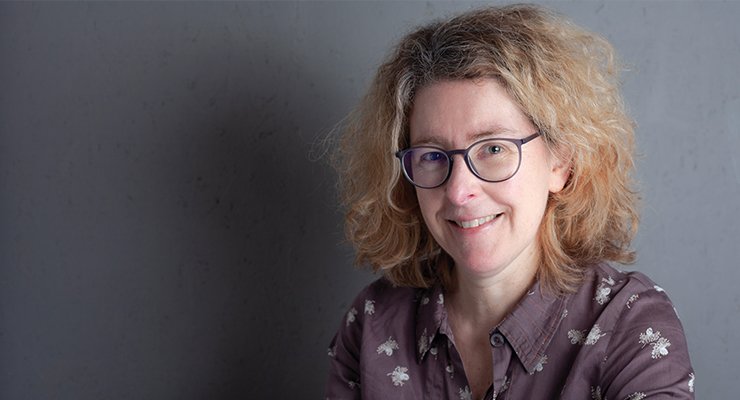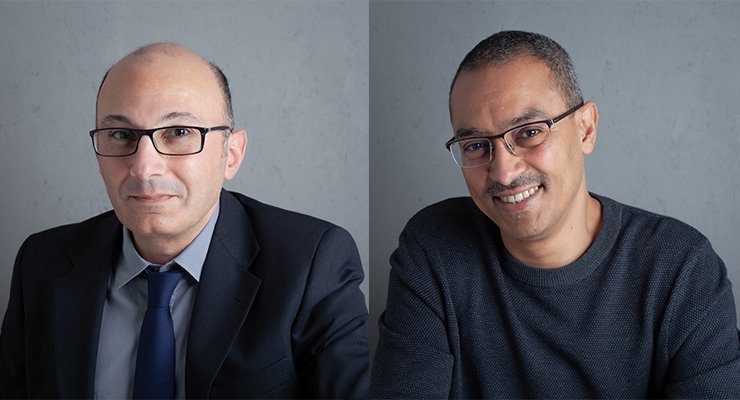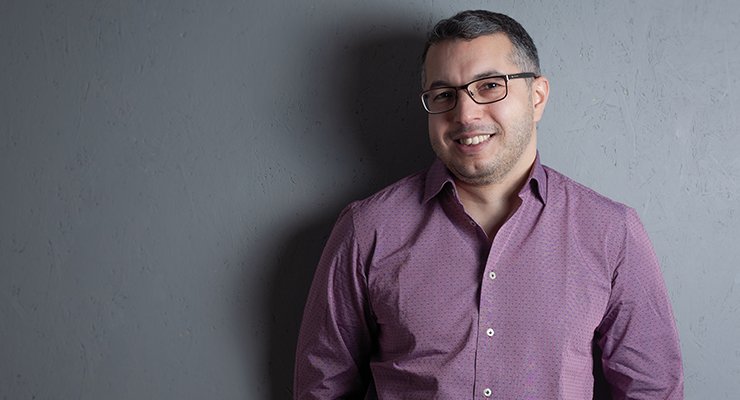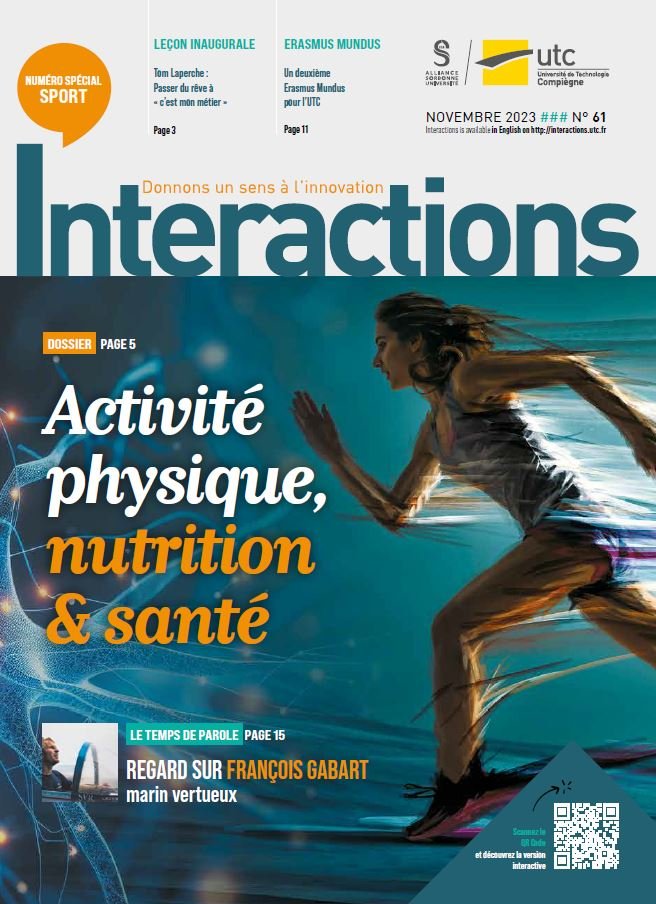
UTC’s Biomechanics and Bioengineering Laboratory (BMBI), a UTC-CNRS joint research unit since it was established in 1982, is dedicated to engineering for health, a field in which UTC, a leader in France, was a pioneer. Work combining biomechanics of the living (whether human or animal), and bioengineering, carried out by scientists in three research teams. Fields of research that cover, for example, the theme of ageing, the repair of valves in the case of functional mitral insufficiency, the modelling of lymph flow, organs- on- a‑chip devices or, more recently, the questions surrounding green dialysis. These are all areas that are shaping the Medicine of the Future.

Cécile Legallais is a senior research director with the CNRS. Since January 2018, she has been director of the UTC’s Biomechanics and Bioengineering Laboratory (BMBI), a joint UTC/CNRS research unit since its creation in 1982.
With some 7 personnel, including – academic professors, research scientists, contract researchers and technical staff -, UTC-BMBI is organised around 3 research teams dedicated to health engineering, a field where the UTC has always been a pioneer in France. “This research investigates the biomechanics of living organisms, both human and animal, and their bioengineering aspects, where we will combine approaches from the engineering sciences with those from the biological sciences involving the study of tissues or cells,” explains Prof. Cécile Legallais.
Can you identify some objectives? “The aim is to contribute, through devices or methods, to improving the health of patients. By understanding how the body, a particular organ or tissue functions, we can propose methods of treatment, diagnosis and even repair through artificial organs or tissue engineering,” she explains.
What are the research themes of the various teams? “One team is working on the personalised characterisation and modelling of the musculoskeletal system. In this case, we seek to understand the functioning of the entire body, such as our muscles, tendons or bones. The second team look at our cardiovascular system and more generally in the flow of blood and lymph in the body, using a multi-scale approach. These two teams combine experimentation and modelling and rely in particular on medical imaging techniques. The 3rd team specialises in tissue engineering, the aim of which is to reconstruct tissues or even organs — skin, liver, nerves, etc. — with different tools (living materials and cells). — with different tools (materials and living cells) and at different scales,’ explains Cécile Legallais.
This research is of great interest to the clinical world. This is reflected in the increasing number of partnerships with the medical world. “We are working with the Amiens University Hospital and, in particular, Professor Devauchelle’s ‘Faire Faces’ Institute. We also have agreed to collaborations with the Pitié-Salpêtrière Hospital on diabetes and sarcopenia, in other words, the ageing of the body, with the Henri-Mondor University Hospital on heart valves and with the Paul-Brousse Hospital on liver pathologies and the bioartificial liver project. More recently, we have been interested in green dialysis in various nephrology departments,’ she concludes.

Nearly 50,000 people suffering from kidney failure in France require treatment by haemodialysis or an artificial kidney. These are people waiting for a kidney transplant or who cannot be transplanted.
For a long time the notion of sustainable development in the field of health care was unheard of, since access to health care for the entire population was considered to be a sustainable development objective per se.
But things are changing and the environmental impact of certain techniques is beginning to be questioned. This is particularly true of dialysis protocols. “First of all, it requires very complex medical devices that have to be produced, transported, etc. It is also very “greedy” in terms of single-use plastics — 1.5 kg of them/ dialysis, thrown away per patient and per session. There is also the transport of patients to the centres and finally the consumption of water. It should be noted that 400 litres of water are used to produce the dialysis fluid for each session. In the end, each patient consumes 75 m³ (75 tonnes) of water per year,” explains Cécile Legallais.
It was in Morocco, where the problem of water shortage is obvious, that the question of dialysis came up. “It all started four years ago when Ahmed Abarkan, a student of Professor Sqalli Houssaïni, head of the nephrology department at Fez Hospital, who was working on the problem of recycling dialysis water, contacted me to do his thesis under our joint supervision,” she points out.
What then is the theme of the thesis? “How to reduce the environmental impact of dialysis? It should be noted that the reverse osmosis process used generates the discharge of large quantities of moderately salty water. How can we desalinate it so that it can be reused? We worked on this problem in collaboration with Professor Grimi of UTC’s TIMR laboratory and the dialysis centre of the Saint-Côme polyclinic, Compiègne, a long-standing partner of the lab,’ she concludes.

Co-leaders of the team (C2MUST) within the UTC-BMBI laboratory, Karim El Kirat and Sofiane Boudaoud are both tenured UTC professors.
A team devoted to investigating the “Characterisation and personalised modelling of our musculoskeletal system”. So, what their respective areas of research? “I work mainly on the characterisation and biomechanical properties of bones, whether human or animal. I also lead the transverse programme ‘Biomechanics of biomimetic and bioinspired systems’ involving the lab’s three teams. And what is the underlying thematic? “The idea is to be inspired, for our often clinical purposes, by the structures and properties seen in humans and in nature in order to manufacture medical devices. The shape and mechanical properties of a tibia prosthesis, for example, must be as close as possible to a natural tibia,” explains Karim El Kirat.
More concretely? “In my field, which concerns the manufacture of bone in vitro, it is extremely important that the bone, on a microscopic scale, has all the characteristics of natural bone but also all its mechanical properties. Why is this so? “The materials developed must be able to be integrated into the body, be recognised as a non-toxic material and finally display the expected biomechanical properties,’ he adds. “This is an area where modelling plays a major role. “My work focuses on signal processing and modelling. These are biomedical signals and, more particularly, electrophysiological signals obtained from measurements of biocurrents on the surface of the human body. Within C2MUST, we have considerable expertise in surface electromyography (EMG). One of the team’s strong themes concerns the characterisation of the neuro-musculoskeletal system thanks to multiple, varied and complementary measurements; measurements that can be mechanical, electrical and noninvasive”, Sofiane Boudaoud explains.
This is how the outlines of a future medicine based on increasingly powerful models are taking shape. “We think that, in the future, medicine will be predictive, preventive and personalised. It will be possible to make diagnoses, sometimes with the help of the model, before the onset of pathologies; robust, early and precise diagnoses, made using the least invasive techniques possible, acceptable to the patient. To achieve this, we will rely on signal processing, advanced data analysis, bioinspired and biomimetic modelling. Thus, the models of the musculoskeletal system on which we are working have been created to mimic natural behaviour in both healthy and pathological conditions. The aim is to provide additional information, in other words, diagnostic assistance to the clinician who is going to make a medical decision,’ he explains.
They apply this know-how to a variety of problems, particularly the characterisation of the ageing of the musculoskeletal system. “We know that by 2050 one in three people will be over 60 and one in ten over 80. There is also the fact, demonstrated by the statistics, of the increase in sedentary behaviour, particularly among young people. Thus, 15–25 year olds today walk less than the 55–65 year old generation. The concomitance of these two phenomena will lead to an acceleration of the problems of ageing and loss of autonomy. This will pose a real public health problem,” he explains.
Among the team’s medium-term objectives? “Our aim is to develop devices worn on the person and connected to the mobile phone that can indicate, for example, to a person suffering from joint pain in the knees or muscular weakness that his or her gait shows all the signs of an imminent fall,” says Karim El Kirat.
“In a partnership with Professor Kinugawa of the AP-HP (public hospitals) and the Sorbonne University Cluster, (SU) we have also developed an indicator called “motor functional age” which may be different from the chronological age. The idea is to alert young and old alike to the state of ageing of their musculoskeletal system,” adds Sofiane Boudaoud.
This problem has led to an industrial partnership. “As part of the French national economic recovery plan, we obtained a project with BioSerenity, a company specialising in connected devices”. What is the aim here? “It is to be able to evaluate ageing using electromyography,” he concludes.

Muriel Vayssade is professor of Cell Biology and Tissue Engineering and is in charge of the Biomaterial Cells and Bioreactors (CBB) team within the UTC-BMBI laboratory. Rachid Jellali, a research engineer, has a transverse role given that he works with both the CBB and IFSB (Biological Fluid Structure Interactions) teams.
What is tissue engineering? “First of all, it is an interdisciplinary field that brings in and combines biology, chemistry, physical chemistry and biomechanics. The underlying idea is to be able to reconstruct in vitro tissues and even organs with all their natural complexity,” explains Muriel Vayssade.
What techniques can be used? “These involve cultivating several cell populations together, as a native tissue is made up of different types of cells. The idea? It is to use biomaterials, natural or synthetic, which will provide a three-dimensional environment for the cells, and then to find the optimal experimental conditions so that they differentiate (specialise) and constitute a functional tissue, similar to a native tissue,” she explains.
The techniques have various fields of application. “For example, we use collagen hydrogels and fibroblasts to reconstitute dermis (skin tissue),” she adds.
This know-how has led to various projects with a number of partners. One of these, established with the Dermatology Department of the Amiens University Hospital, concerns the treatment of metastatic melanoma. “Clinicians were confronted with both successes and failures and wanted to understand why certain molecules were effective on one patient and not on another. We therefore microenvironment, in which we can cultivate patients’ tumour cells (isolated from biopsies), test the response of the cells to the treatments and thus identify in vitro the sensitivity of the patient to this or that type of molecule,” says Muriel Vayssade.
Work in partnership with the University of Hanover, Germany and financed by the French national ANR is also being carried out on the reconstitution of bone, tendon and muscle, in the same continuity, using a biomimetic approach. “We are going to use materials shaped according to the desired tissue: for example, associated with minerals such as hydroxyapatite (a natural component of bone), or organised in the form of fibres (like muscles) and apply mechanical stresses (stretching) in order to encourage the differentiation of cells into bone, muscle, etc.”, she emphasises.
Another line of research? “We have set up an organs-on-chip technology. The idea? It is to cultivate cells in microfluidic devices (a technology inspired by microelectronics) or mini-bioreactors. Among the advantages of this technology, we have in a 3‑dimensional, well-controlled microenvironment that can be perfused and whose shape can be adapted to the organ we want to study. My main goal is to use them in toxicology to replace animal testing in particular. For example, in drug screening, many drugs pass the animal test phase and fail because the difference between animal and human physiology is enormous,’ explains Rachid Jellali. What are the organs concerned? “We started working on the liver, the ‘metabolising’ organ par excellence, and then, step by step, we started looking at all the organs that interact with the liver, such as the kidneys and the pancreas, the aim being to reproduce the interactions between several organs,” he explains.
These skills have led to various projects with a number of partners. One, conducted jointly with two Lille laboratories, SMMIL‑E and IEMN, with partners HCS Pharma and Fluigent, is financed by the ANR. This MimLiverOnChip project aims to develop a biomimetic liver on a chip. The team is also working on projects funded by ANSES (IMITOMICS, LuLi) and the UTC Foundation, and is using these organs on chips to study the toxicity of pesticides on the liver and lungs.

Badr Kaoui is a member of the IFSB (Biological Fluid Structure Interactions) team in the UTC-BMBI Laboratory. His research interests include the numerical modelling of fluid-structure interactions coupled with transport phenomena in biological and biomedical systems. He is an expert in the Boltzmann network method and is a pioneer in France in the modelling of lymph pumping.
Among the application areas ? “My research is in the biomedical field — the calculation of flow and mass transfer in biomedical systems such as artificial organs on microfluidic chips, for example — but also in biology, in particular the study of the lymphatic system. It is thanks to multiphysical simulations that we can calculate, for example, the flow of a given fluid and the diffusion-advection-reaction of chemical entities,” he explains.
Can you describe one of the techniques used for modelling? “Firstly, the Boltzmann method. What’s in it for me? It is simple to program and allows the code to be made increasingly complex depending on the problems dealt with; it can also be easily ‘parallelized’, i.e. simulations can be run on several processors to reduce the calculation time; finally, it is useful for calculating both the flow of a fluid and mass transfer. We can also couple the two in the case of the transport of a drug by a fluid such as blood, for example”, he stresses.
A numerical method that he now couples with the immersed boundary method, which is more modern, very advanced and particularly well suited to deformable structures. “Thus, if we take the lymphatic system, we can go from biomechanics — the flow of a fluid in a living system — to mechano-biology, where we are interested in biochemical signals that induce forces that lead to the dynamics of the walls and valves of lymphatic vessels,” adds Badr Kaoui.
What is his specific interest in the lymphatic system? “It was when I was at Massachusetts General Hospital (MGH), known worldwide for their expertise in cancer treatment that I first heard about the lymphatic system and its link to cancer. A complex system that has not been extensively studied. Far from shying away from the difficulty, I decided to make it a new focus of my research and to use all the digital tools I had developed,” he explains. A line of research that interests Dr Lance Munn, associate professor at Harvard Medical School, researcher at the MGH, and also Visiting Professor at UTC. “We have set up a joint project, financed by the ANR and conducted in collaboration with the MGH, to understand the lymph pumping mechanism at the vessel level,” he says.
What is special about the project? “Usually, we work on the biomechanics and interaction of structural fluids in the UTC-BMBI-IFSB team. In this project, we are going to add biochemistry, the functioning of valves and then progress towards 3D models,” concludes Badr Kaoui.

Khalil Ben Mansour, a research engineer, has been co-director of the Centre of Expertise for the Biomechanics of Movement since 2020. He designed the ErgoSkel, a handling aid, which has been patented nationally as well as in the United States and Japan and will be market launched in April 2022.
In 2011, he joined UTC for a threeyear European project dedicated to the development of a diagnostic tool for musculoskeletal back disorders as a post-doc. At the end of the project, he was recruited as a research engineer, responsible for the “Technology, sport, health” platform, which has since been renamed the “Centre of expertise for the biomechanics of movement”.
Among the platform’s objectives? “The aim is to evaluate the movements of humans and animals in order to understand them better, to find solutions for improving the environment in which they move and to reduce the risks of musculoskeletal disorders, accidents, etc. I carried out various projects in areas such as sport and health, ergonomics at work and monitoring rehabilitation in the medical field,’ he explains.
A recognised know-how. The proof is “Ergoskel”, a flagship project launched in 2017 at the initiative of FM Logistic, a company with almost 29 000 employees operating in 14 countries in Europe, Asia and Latin America. “Faced with the number of work stoppages due to musculoskeletal disorders affecting its employees, the company invited us to think about a device that would be light, inexpensive and enable the workload on the upper limbs to be reduced in order to avoid the onset of limb and back disorders,” he says.
The ergoskeleton, which on sale as of April 2022, is a success. “It is a device that is worn like a backpack. It weighs 1.8 kg and can reduce muscle fatigue by a factor of three,” concludes Khalil Ben Mansour.
Two devices for the treatment of functional mitral insufficiency are currently the subject of international patent applications.
The first one relates to the implantation of a balloon between the two mitral valve leaflets in order to fill the residual space between them, has already been patented in France and is awaiting international patenting.
However, Anne-Virginie Salsac, director of research at the CNRS working at in the Biomechanics and Bioengineering Laboratory (UTC-BMBI), admits that this technique is very complex and may not be suitable for all situations of functional mitral insufficiency.
Hence the idea of a second device characterised by a purely metallic structure, covered by a membrane to avoid abrasive effects, this device being protected by an international patent application. “After numerous market studies, the project was judged to be sufficiently innovative and to have great industrial potential. This earned it the support of the SATT Lutech in Paris. All that remained was to find a partner specialised in the medical field who would be prepared to take on the role of ‘co-maker’,” explains Anne-Virginie Salsac. This was achieved with 3D Med Lab, a company specialised in the printing of 3D devices. “The idea is to implement 3D printing both with biopolymers for the “balloon” solution and with “metal” printing such as Nitinol, a shape memory alloy,” she explains.
A pioneer in the training of actors in the biomedical sector, UTC is still the leader in France. But other actors have now invested the field.
This Bio-Med Rendezvous was launched by Isabelle Claude and Jean-Matthieu Prot, both lecturer-cum-research scientists in bio-engineering, and whose fourth edition was held on January 21, 2022.
The reason for this initiative? “One of the reasons is the 40 year long history and proximity of UTC with the biomedical field, which gives it a great reputation. However, for the last fifteen years, new actors have invested this field with a lot of dynamism and in particular by creating recurrent events which give them an important visibility. So we agreed among ourselves that UTC should not be satisfied with its good reputation but that it should better communicate on its know-how and thus increase its participation in the French biomedical network”, explains Isabelle Claude.
“For us, this event aims at highlighting all the biomedical activities of UTC, promoting the students’ projects, developing the research activities carried out within the university but also to consolidate its links with privileged external partners. Thus, we always bring in either a hospital practitioner or a biomedical industrialist”, adds Jean-Matthieu Prot. What was the theme of the last biomedical meeting? “We focused the day on surgical robotics and the modernisation of the operating theatre,” he concludes.
Senior lecturer Anne Le Goff is a member of the IFSB team in the UTC-BMBI laboratory. A research project on soil bioremediation brings together both UTC-BMBI and UTC-TIMR Laboratories.
The project title « Myco-fluidics for soil bio-remediation», in other words, the use of fungi for soil decontamination, this cross-disciplinary project brings together the skills of two UTC laboratories.
“Our objective is to visualise, within a micro-fluidic system, the way in which a fungus accesses a pollutant such as hydrocarbons, for example. We know that certain filamentous fungi can be effective. It remained to demonstrate how. By ‘solubilising’ the pollutant or by feeding on it,” she explains.
A project that is the subject of three theses. “Claire Baranger’s thesis, based on videomicroscopy monitoring of fungi and the pollutant incorporated into microfluidic chambers, demonstrated the coexistence of the two approaches; Jérémy Audierne’s thesis aims to define the optimal conditions under which the fungus can develop at the micro level and whether this can be verified in the field; and Salomé Bertone’s thesis is devoted to the biological aspect of the project. Searching for other microbial candidates, for example,” she explains.
How are these PhD theses funded? “The first two were supported by the Ministry of HE, Research & Innovation and the Region, and the 3rd by the MSTD Institute,” concludes Anne Le Goff.




